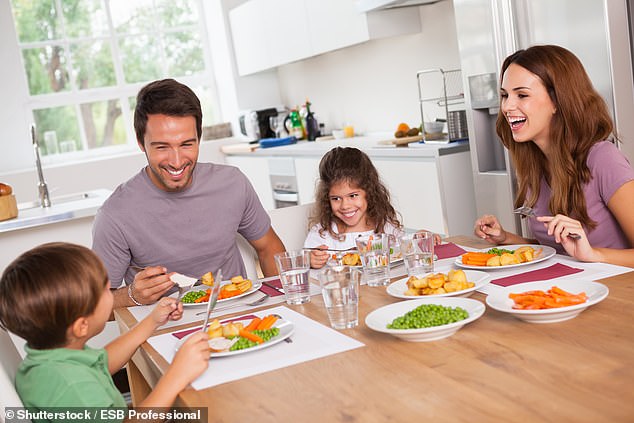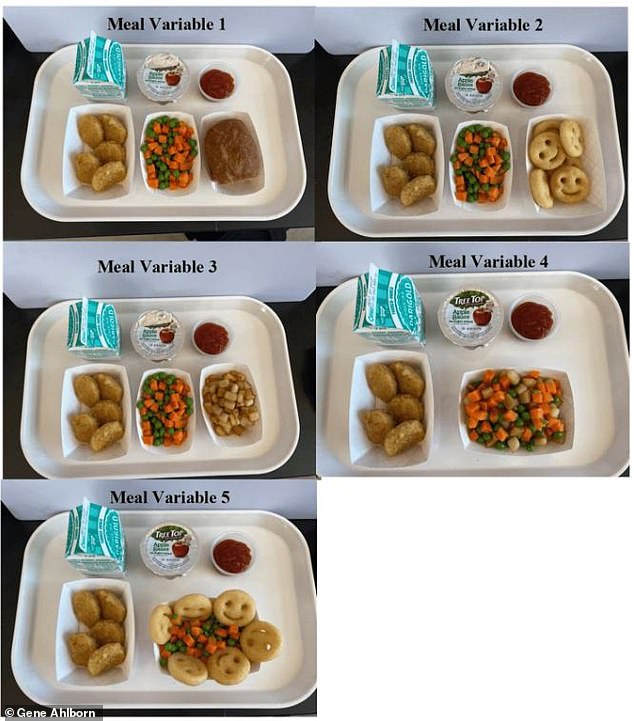How to get kids to eat more veg? Serve it with smiley faces! Children eat 52% more vegetables if they’re in the same bowl as fun potato shapes, study finds
>
It is known that mothers and fathers find it difficult to convince their children to eat enough vegetables.
But help has finally arrived, as scientists have revealed the surprising secret to getting kids to eat vegetables.
Researchers from Brigham Young University found that children ate up to 52% more peas and carrots when they were presented with potato smiles.
However, there is an important caveat – the effect only applies when the potatoes are served in the same bowl as the vegetables.
Professor Jane Ahlborn said: ‘Not only do potatoes add nutrients, such as potassium, directly to the plate, but they may also help encourage children to explore other vegetables they are offered, thus helping them get closer to their overall nutritional needs.’ Lead author of the study.
The surprising secret to getting your kids to eat more vegetables is to offer them potato smiles, according to scientists (stock image)
In the United States, dietary guidelines recommend that children ages 3 to 18 eat about three cups of vegetables daily.
However, Professor Ahlborn points out that the average school child only has one cup a day.
Meanwhile, a recent study in the United States found that half of American children do not eat a single vegetable a day.
“That’s why we wanted to learn more about how school meal offerings influence children’s eating behavior and potentially encourage increased vegetable consumption,” he explained.
In the study, researchers fed the children a controlled meal consisting of chicken nuggets, 2 percent milk, ketchup, applesauce, peas and carrots, and some form of potatoes or bread.
The children’s meals were weighed before and after to see how different meal offerings influenced what they chose to eat.
In the control trial, where the bread roll was served on the side, children ate 21.1 grams of vegetables with their meals.
When the meal was served with potato smiley faces in a separate bowl from the vegetables, the researchers found that the amount of vegetables eaten actually decreased by 20 percent.

Researchers found that children ate more peas and carrots when fun potato shapes were served in the same vegetable bowl (stock image)

In the study, researchers fed the children a controlled meal consisting of chicken nuggets, 2 percent milk, ketchup, applesauce, peas and carrots, and some form of potatoes or bread.
However, when the smileys and vegetables were served in the same bowl, the children ate 51% more vegetables than when they were served separately.
While the study notes that this improvement is not dramatic, they wrote that “even small steps toward improving vegetable consumption are important for enhancing nutritional intake.”
Professor Ahlborn also says this trick can reduce food waste by making sure you eat more vegetables.
“We want the vegetables on school lunch trays to nourish children’s bodies – not to fill the trash,” he adds.
If you’re trying to help your kids eat more vegetables at home, you may be concerned that potato smiles aren’t the healthiest choice.
However, the study found that adding potato smiles to a meal adds only 21 calories and 5 grams of fat, all of which are trans.
Professor Ahlborn also tested the effect of other potato shapes on vegetable consumption by including spiced potato squares.
However, the study found that less pleasant-looking potatoes had a smaller effect on the amount of vegetables children ate during the meal.
When served separately, potato cubes resulted in a slight increase in vegetable intake compared to the control group with children eating just over 2 grams more.
However, when potatoes were served in the same bowl, the amount of peas and carrots eaten dropped to just 20.8 grams.
The authors say the reason for this difference is unknown, but they suggest it may be because potato smiles are more familiar to babies.
“Getting children to eat vegetables is always a challenge,” Professor Ahlborn joked.
(Tags for translation) Daily Mail
